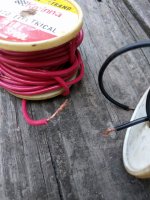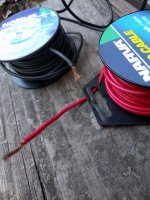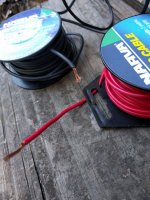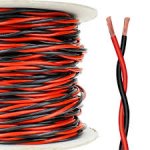Hi All.
I have some rolls of insulated 3mm multi strand copper core wire which was marketed for automotive purposes.
Two rolls are from the seventies, made in Taiwan.
The metal appears fresh and bright when insulation is sheathed and is non magnetic.
Two rolls are of recent manufacture, also 3mm copper and marked 10 amps.
These are also non magnetic.
Are these suitable for wiring Loudspeakers internally?
thanks
Cliff
I have some rolls of insulated 3mm multi strand copper core wire which was marketed for automotive purposes.
Two rolls are from the seventies, made in Taiwan.
The metal appears fresh and bright when insulation is sheathed and is non magnetic.
Two rolls are of recent manufacture, also 3mm copper and marked 10 amps.
These are also non magnetic.
Are these suitable for wiring Loudspeakers internally?
thanks
Cliff
Attachments
Last edited:
Perfectly suitable, just twist the red and black strands together to form the speaker cable.Are these suitable for wiring Loudspeakers internally?
P.S. I've never heard of 'magnetic' wire. It's normally copper (good), copper clad aluminium (not so good), silver clad copper (very good) or pure silver (excellent, but very expensive!).
Attachments
I certainly have. Steel / copper clad steel wire for a start. And there was a fad for various types of magnetic wires in interconnects about 30 years back. Some generous souls are flogging interconnects with magnetic wires and magnets in the connectors (no less) right now, although I can't recall the name of the company off hand. Thank goodness. 😉
I can't recall the name of the company off hand. Thank goodness. 😉
LOL Scott, and Happy New Year!
Yeah, Scott, I forgot about copper-clad steel!
Still used for the inner conductor of some coaxial TV cables.
Copper-clad steel - Wikipedia
Still used for the inner conductor of some coaxial TV cables.
Copper-clad steel - Wikipedia
Last edited:
This one perhaps? Speaker Cable, Home Theater, Audiophile | Different Types of Audio Cables - High Fidelity CablesSome generous souls are flogging interconnects with magnetic wires and magnets in the connectors (no less) right now, although I can't recall the name of the company off hand. Thank goodness. 😉
Yes, that's the one. I had successfully erased it from my mind until now. 😉
Happy New Year one and all. I hope it is a healthy and a happy one for everybody, and that if desired, we all become as wealthy as, say, the owners of Transparent Cable (I'm inferring, but I suspect not by a lot...). OK, that's the sardonic bit over: humour aside, I truly wish everybody the very best for 2021 and I hope it proves a much better one for everybody. 🙂
Happy New Year one and all. I hope it is a healthy and a happy one for everybody, and that if desired, we all become as wealthy as, say, the owners of Transparent Cable (I'm inferring, but I suspect not by a lot...). OK, that's the sardonic bit over: humour aside, I truly wish everybody the very best for 2021 and I hope it proves a much better one for everybody. 🙂
Last edited:
unless you run PA, so is home audio
most of the time we never use more than one watt
less than in car when it comes to voltage
most of the time we never use more than one watt
less than in car when it comes to voltage
Perfectly suitable, just twist the red and black strands together to form the speaker cable.
Thanks G.
Are you saying to double the gauge by twisting two lengths together?
Isn't the 3mm single cable thick enough?
Thanks
C
He said:
Call them send/return if you wish.
NOT:twist the red and black strands together to form the speaker cable
Just wisting hot and ground cables so they tend to stay together.double the gauge
Call them send/return if you wish.
unless you run PA, so is home audio
Exactly, a typical 100w home audio amplifier only produces about 28v at the speaker terminals.
Yes, 3mm is quite thick enough for the short run of cable inside a speaker enclosure.Isn't the 3mm single cable thick enough?
Remember that the resistance of a wire increases with length and decreases with thickness.
Thicker wire is only required for very long cable runs when it is necessary to increase the thickness to compensate for the increase in length.
Exactly, a typical 100w home audio amplifier only produces about 28v at the speaker terminals.
The op did not specify home audio and I have no control over who else might read and or how they will act on any advice given so I believe the warning was fair comment.
I believe some use 1000W subwoofer for home use. Someone else might think if the cable is suitable for speaker wiring it may also be used inside an amplifier where it is unsuited. Not everyone will be aware that Automotive cable is only rated for low voltage. 🙂
Thanks russc.
I absorbed most of what you've said.
The voltage has passed a transformer in an Amp to a lower voltage before being processed and sent to the Loudspeakers.
I'd never use the auto cable for mains voltage use.
I don't have a lot of experience with Subwoofers so don't know the range of watts they come in.
If I ever rewire a Sub, I'll be sure to enquire here before dabbling.
cheers
Cliff
I absorbed most of what you've said.
The voltage has passed a transformer in an Amp to a lower voltage before being processed and sent to the Loudspeakers.
I'd never use the auto cable for mains voltage use.
I don't have a lot of experience with Subwoofers so don't know the range of watts they come in.
If I ever rewire a Sub, I'll be sure to enquire here before dabbling.
cheers
Cliff
- Home
- Design & Build
- Parts
- Is this suitable wire for Loudspeaker internals?




